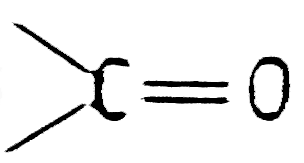Aldehydes and ketones are amphoteric. Thus they can act both as acids and bases. Under acidic conditions, the carbon of the protonated canbonyl group is much more electrophilic, reacting even with weak nucleopphilie. Carbonyl compound gives nucleophilic addition reaction. In this reaction the nucleophilic attack proceeds the elecrophilic attack.
Carbonyl compounds gives nucleophilic addition with
carbon nucleophile
oxygen nucleophile
Nitrogen nucleophile
All of these
The correct Answer is:D
Step by step video, text & image solution for Aldehydes and ketones are amphoteric. Thus they can act both as acids and bases. Under acidic conditions, the carbon of the protonated canbonyl group is much more electrophilic, reacting even with weak nucleopphilie. Carbonyl compound gives nucleophilic addition reaction. In this reaction the nucleophilic attack proceeds the elecrophilic attack. Carbonyl compounds gives nucleophilic addition with by Chemistry experts to help you in doubts & scoring excellent marks in Class 12 exams.
Topper's Solved these Questions
- BOOK - ALLENCHAPTER - ALKENE, ALKANE & ALKYNE EXERCISE - EXERCISE-4(A)10videos
ALKENE, ALKANE & ALKYNE
- BOOK - ALLENCHAPTER - ALKENE, ALKANE & ALKYNE EXERCISE - EXERCISE-4(B)10videos
ALKENE, ALKANE & ALKYNE
- BOOK - ALLENCHAPTER - ALKENE, ALKANE & ALKYNE EXERCISE - EXERCISE-1119videos
ALKENE, ALKANE & ALKYNE
- BOOK - ALLENCHAPTER - AIIMS 2019EXERCISE - CHEMISTRY35videos
AIIMS 2019
- BOOK - ALLENCHAPTER - ALKYL AND ARYL HALIDEEXERCISE - EXERCISE-05 (B)37videos
ALKYL AND ARYL HALIDE
Similar Questions
Knowledge Check
- Question 1 - Select One
Aldehydes and ketones are amphoteric. Thus they can act both as acids and bases. Under acidic conditions, the carbon of the protonated canbonyl group is much more electrophilic, reacting even with weak nucleopphilie. Carbonyl compound gives nucleophilic addition reaction. In this reaction the nucleophilic attack proceeds the elecrophilic attack.
Which one of the carbonyl compounds is more reactive towards NaCN/H+?A_E01_576_O01.png) B
B_E01_576_O02.png) C
C_E01_576_O03.png) D
D_E01_576_O04.png)
- Question 2 - Select One
Aldehydes and ketones are amphoteric. Thus they can act both as acids and bases. Under acidic conditions, the carbon of the protonated canbonyl group is much more electrophilic, reacting even with weak nucleopphilie. Carbonyl compound gives nucleophilic addition reaction. In this reaction the nucleophilic attack proceeds the elecrophilic attack.
Which of these statements are correct?ACarbonyl compound is amphoteric in characterBAcid catalyst makes the carbonyl more electrophilicCbasic catalyst makes the nucleophilic attack more faster.DAll of these - Question 3 - Select One
Aldehydes and ketones are amphoteric. Thus they can act both as acids and bases. Under acidic conditions, the carbon of the protonated canbonyl group is much more electrophilic, reacting even with weak nucleopphilie. Carbonyl compound gives nucleophilic addition reaction. In this reaction the nucleophilic attack proceeds the elecrophilic attack.
Which of the statements are//is correct?AThe rate determining step of addition reaction is the addition of nucleophileBThe rate-determining step is addition of electrophileCThe reaction intermeidate of the reaction is alkoxide ionDboth (A) and (C )
Alkenes
 and carbonyl compounds
and carbonyl compounds  both contain a π bond but alkenes show electrophilic addition reactions whereas carbonyl compounds show nucleophilic addition reactions. Explain.View Solution
both contain a π bond but alkenes show electrophilic addition reactions whereas carbonyl compounds show nucleophilic addition reactions. Explain.View Solution(A) Carbonyl compounds take part in nucleophilic addition reactions.
(R) These reactions are initialed by nucleophilic attack at the electron deficient carbon atom.View SolutionAssertion : Carbonyl compounds take part in nucleophilic addition reactions.
Reason : These reactions are initiated by nucleophilic attack at the electron deficient carbon atom.View SolutionWhich carbonyl group of the given compound is most reactive for nucleophilic addition reaction ?
 View Solution
View SolutionIdentify the example in which nucleophilic addition and nucleophilic addition elimination reaction both occur respectively in the carbonyl compound.
View Solution

